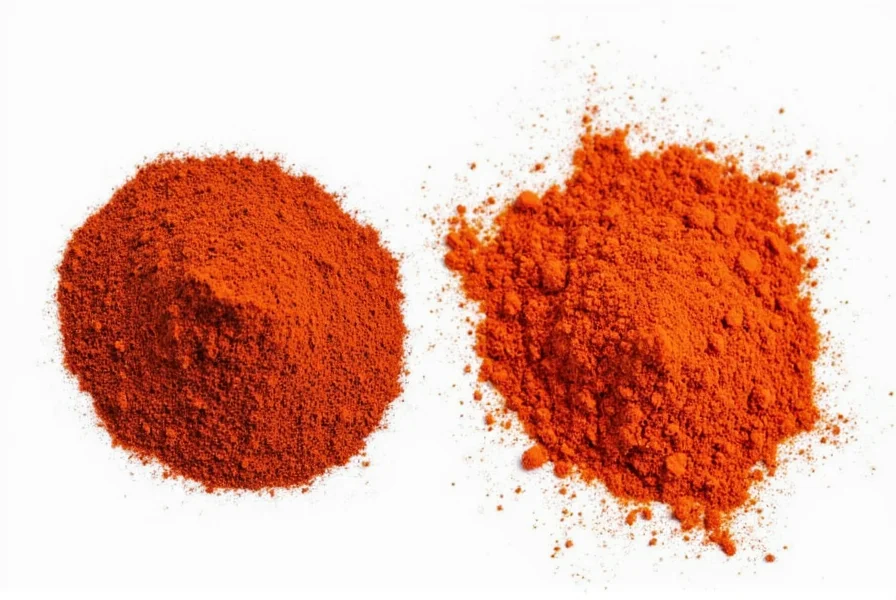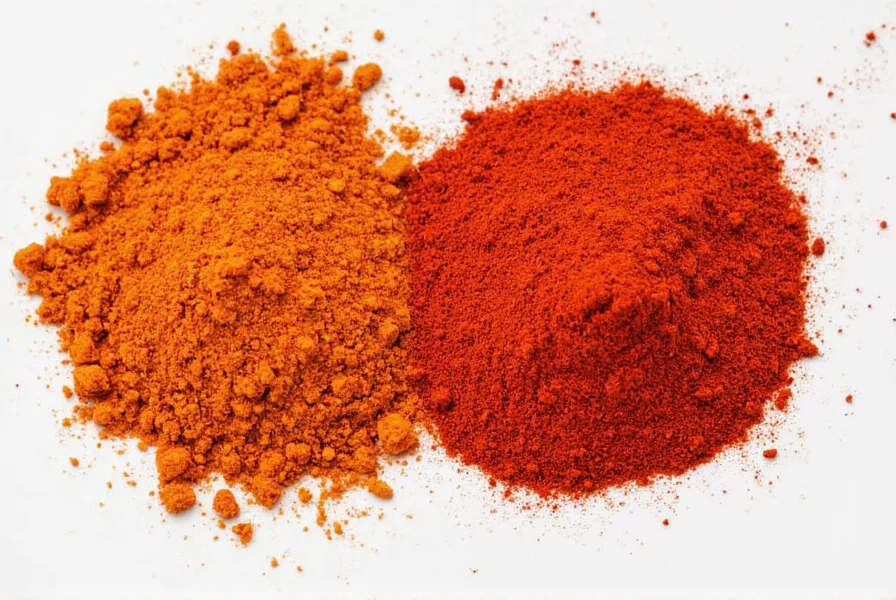Chili powder and cayenne powder are both red spice powders but serve very different purposes in cooking. Chili powder is typically a blend of ground chilies and other spices, while cayenne powder is made from pure ground cayenne peppers. This fundamental difference affects their heat levels, flavor profiles, and culinary applications.
| Characteristic | Chili Powder | Cayenne Powder |
|---|---|---|
| Main Ingredient | Blend of ground chilies, cumin, garlic, oregano, and sometimes salt | Pure ground cayenne peppers (Capsicum annuum) |
| Flavor Profile | Earthy, complex, mildly spicy with layered notes | Sharp, intense heat with bright peppery notes |
| Typical Heat Level | 500-5,000 SHU (varies by blend) | 30,000-50,000 SHU |
| Primary Culinary Use | Flavor base for Tex-Mex dishes, stews, and rubs | Adding intense heat to sauces, marinades, and spice blends |
What Is Chili Powder?
Chili powder in the United States is almost always a spice blend, not pure ground chilies. It typically contains ground chilies (like ancho, guajillo, or pasilla) combined with cumin, garlic powder, oregano, and sometimes salt. In Mexico, pure ground chilies are called "chile en polvo" rather than "chili powder."
What Is Cayenne Powder?
Cayenne powder is made exclusively from dried, ground cayenne peppers (Capsicum annuum). It contains no additives or other spices unless specified on the label. Cayenne peppers are known for their intense heat and vibrant red color, making cayenne powder a pure heat source rather than a flavor enhancer.
Heat Levels Compared
| Spice | Scoville Heat Units (SHU) | Relative Heat Level |
|---|---|---|
| Chili Powder (blend) | 500-5,000 SHU | Mild to moderate |
| Cayenne Powder | 30,000-50,000 SHU | Very hot |
| Jalapeño Pepper (fresh) | 2,500-8,000 SHU | Moderate |
| Tabasco Pepper | 2,500-5,000 SHU | Moderate |
One teaspoon of cayenne powder contains approximately the same heat as 1-2 tablespoons of chili powder blend. Cayenne powder is 10-50 times hotter than most chili powder blends.
When to Use Each Spice
Best Uses for Chili Powder
- Classic chili con carne and bean dishes
- BBQ dry rubs for meats
- Taco seasoning and enchilada sauces
- Stews and soups where complex flavor is desired
- Homemade tortilla chips and roasted vegetables
Best Uses for Cayenne Powder
- Hot sauces and salsas where intense heat is needed
- Marinades for grilled meats and seafood
- Spicy popcorn and snack seasonings
- Boiled seafood boils and crab boils
- Adding heat to smoothies, tonics, or wellness drinks

Buying Guide: What to Look For
Choosing Chili Powder
- Check the ingredients list - pure chili powder blends should list chilies first, followed by spices like cumin and garlic
- Look for brands that specify the types of chilies used (ancho, guajillo, etc.)
- Avoid blends with artificial flavors or excessive fillers
- Store in a cool, dark place to preserve freshness
Choosing Cayenne Powder
- Ensure it's 100% cayenne pepper with no additives
- Check for a vibrant red color (faded color indicates age)
- Look for opaque packaging to protect from light exposure
- Higher capsaicin content means more heat and better shelf life

Frequently Asked Questions
Can I substitute chili powder for cayenne powder in recipes?
Yes, but with significant adjustments. Since cayenne powder is 10-50 times hotter than chili powder, use 1/4 teaspoon cayenne for every 1-2 tablespoons of chili powder called for. However, this substitution will change the flavor profile since chili powder contains additional spices like cumin and garlic. For best results, use chili powder for flavor and add cayenne separately for heat.
Does chili powder contain cayenne pepper?
Most commercial chili powder blends in the U.S. contain some cayenne for heat, but the amount varies by brand. Authentic Mexican "chile en polvo" typically does not contain cayenne and is made from pure dried chilies like ancho or guajillo. Always check the ingredients list to know exactly what's in your chili powder.
How much hotter is cayenne than chili powder?
Cayenne powder is typically 10-50 times hotter than chili powder blends. While chili powder averages 500-5,000 Scoville Heat Units (SHU), cayenne ranges from 30,000-50,000 SHU. One pinch of cayenne (about 1/8 teaspoon) equals the heat of 1-2 tablespoons of chili powder.
Can I make my own chili powder blend at home?
Yes. For authentic Mexican-style chili powder, toast and grind dried ancho or guajillo chilies. For American-style, combine 2 tablespoons ground ancho chilies, 1 teaspoon cumin, 1/2 teaspoon garlic powder, 1/4 teaspoon oregano, and a pinch of cayenne (optional). Toasting whole spices before grinding maximizes flavor and aroma.
Do these spices lose potency over time?
Yes, both lose potency within 6-12 months. Store in airtight containers away from light and heat. Cayenne retains heat longer due to higher capsaicin content, while chili powder blends lose complex flavors faster. Test potency by smell - weak aroma indicates it's time to replace. Never store above the stove or near heat sources.










 浙公网安备
33010002000092号
浙公网安备
33010002000092号 浙B2-20120091-4
浙B2-20120091-4